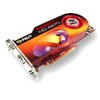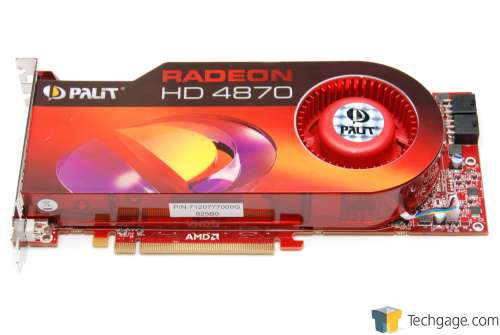- Qualcomm Launches Snapdragon 4 Gen 2 Mobile Platform
- AMD Launches Ryzen PRO 7000 Series Mobile & Desktop Platform
- Intel Launches Sleek Single-Slot Arc Pro A60 Workstation Graphics Card
- NVIDIA Announces Latest Ada Lovelace Additions: GeForce RTX 4060 Ti & RTX 4060
- Maxon Redshift With AMD Radeon GPU Rendering Support Now Available
Palit Radeon HD 4870 512MB

If you’ve been holding off on an upgrade for a while, there’s no reason to continue if a gaming addiction is pulling at your sleeve. The selection for mid-range cards right now is ideal, and anything you pick up will deliver good performance for the money. The best card for the buck right now might be the HD 4870, and we take Palit’s version for a spin to find out why.
Page 13 – Power Consumption, Final Thoughts
In testing power consumption for our graphic cards, the system components are kept consistent to help keep accurate results. To capture wattage, a Kill-a-Watt is used. It is plugged straight into the wall and the PSU is plugged in directly to it. After the computer boots into Windows and is left idle for five minutes, the idle wattage is captured.
To capture the average, a run of 3DMark Vantage is run while keeping an eye on the voltage for the first two minutes. I record the value that the Kill-a-Watt reports the majority of the time. Sometimes the wattage might go higher, but scale right back down, and vice versa.

AMD’s latest series of cards might run super-hot, but they manage to use less power overall when compared to NVIDIA’s offerings. The HD 4870, as we’ve seen, is far superior to the 9800 GTX, but the latter uses slightly more power. Compared to the HD 4850, the HD 4870 uses just 24W more on average.
Final Thoughts
It’s certainly old news by now, but AMD’s 4000-series is a winner in all sense of the word. As mentioned in the intro, when NVIDIA released their GTX 200-series this summer, AMD wasted no time in showing them who’s boss, and I think it surprised us all. When the GTX 280 first hit, I was impressed. It was a beast, no two ways about it, but AMD came along with their HD 4870 X2 and people were in awe.
Luckily, the single-GPU HD 4870 is an equally great offering. It costs almost half of the HD 4870 X2, and outperforms NVIDIA’s previous high-end card, the 9800 GTX. Although we don’t have a GTX 260 here for comparison, I do know that other trusted editors have found the HD 4870 to be the superior card of the two. In some cases, even the HD 4850 can out-perform it. Indeed, it’s going to be a tough quarter for NVIDIA, and now they know how AMD have felt for the past two years.
The question to answer is whether or not this card is for you, and that answer is probably ‘yes’. If you have ~$300 to spend on a GPU, you simply cannot go wrong with this one. It’s more powerful than the GTX 260 in most cases and handles almost every-single one of our games like a dream, even at the ultra-high resolution of 2560×1600. It’s a mid-range card that feels like a high-end card.
What about the hardcore gamers, though? If you happen to have a nice 24″ or higher monitor and want the ultimate in performance, then a $300 card is probably only the beginning for you. You could pick up a single card now, see how it treats you, then upgrade later by picking up another. Those of you with 30″ behemoths might want to jump the gun and pick up a dual-GPU version of the card, especially if you enjoy using anti-aliasing throughout most of your games.
Palit has once again delivered a great offering here, and included all the accessories you might need. The only thing missing might be an included game, but no other company’s HD 4870 included one either. Overall, this is a truly great card, and it would undoubtedly be the first choice of mine if I were on the look-out for a new card in this price-range.
-
Pros
- Top performer for the price-range.
- Handles games up to 2560×1600 with ease.
- Accessories include HDMI, TV-Out and VGA adapters.
- Can upgrade later by adding a second card.
-
Cons
- Card gets hot, regardless of whether it’s at full-load.

Palit Radeon HD 4870
Discuss in our forums!
If you have a comment you wish to make on this review, feel free to head on into our forums! There is no need to register in order to reply to such threads.
Support our efforts! With ad revenue at an all-time low for written websites, we're relying more than ever on reader support to help us continue putting so much effort into this type of content. You can support us by becoming a Patron, or by using our Amazon shopping affiliate links listed through our articles. Thanks for your support!






